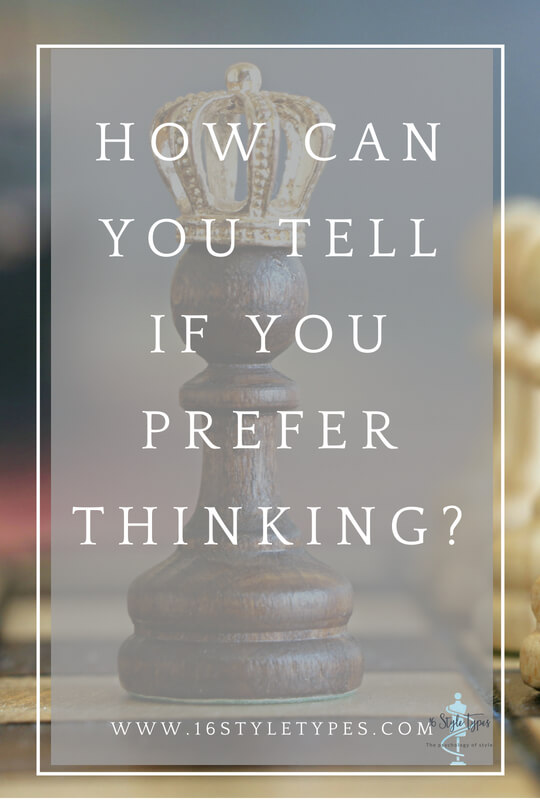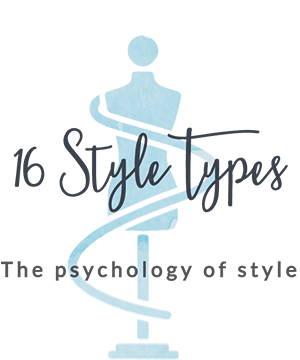In this two part video post on women who have a preference for Thinking, one of the two decision making dichotomies in the psychological type theory we use as the basis for 16 Style Types, we are going to talk about: how you know if you prefer Thinking?
Watch The Video
This is such an intriguing topic because there are many nuances and multi-layered elements if you’re a woman who prefers Thinking, there can also be myths, misconceptions and expectations that others hold about women who prefer Thinking.
First of all, what is Thinking?
Thinking is a decision making function
In its simplest and most technically correct form, Thinking is one way that people make decisions, based on the Jung/Myers Briggs model of personality. Its psychological opposite is Feeling.
People who prefer Thinking –
- Make decisions based on impersonal, objective logic
- Are concerned with principles such as truth and justice
- Spontaneously critique
- Emphasize logic and analysis
Women who prefer Thinking sometimes, maybe even often, know they aren’t “like other women” (and by that, they mean women who prefer Feeling). Depending on their level of self-awareness, Thinking women may have a sense that others find their logic-driven approach unexpected and sometimes (or often) challenging, so they have learned to temper their natural instincts. Or they may be unaware of the impact they are having on others.
People who prefer Thinking often say they are very good at compartmentalizing. They can carve off parts of their life and deal with them separately. This can have the effect on some others (those who prefer Feeling being the obvious culprits!) of the Thinking person coming off as being a little aloof and cold. They are simply more able to “put feelings aside” and get on with what needs to be gotten on with. One downside of this approach is that sometimes those issues to do with feelings are never fully explored, they are never picked up again after being put aside.
Thinking people can sometimes feel less competent when it comes to dealing with emotions, both in reading the emotions of others and handling their own. They often don’t have the need to pick up on emotional stuff, whether that’s the less positive side of the equation (where feelings may be hurt for instance) or the positive side of the equation (such as celebrating where important or positive things have happened). One downside here is that those who are experiencing those emotions — hurt or celebratory – can feel dismissed, ignored or discounted.
Not all T’s are the same
Thinking is just one aspect of a person’s four-letter type code, and makes up eight (8) of the 16 Style Types, the other half having a preference for Thinking’s opposite, Feeling. You can read about all 16 Style Types here.
Here at 16 Style Types we deal in what is called “whole type”, which is about looking at the entirety of your four-letter type code and how all those elements play together to form your psychological profile. In this way, pulling Thinking out as a separate dimension is a little mechanical and unnatural. That said, it can be helpful to “unpack” the various elements that combine with Thinking that make it show up differently, so long as we always circle back to whole type.
So let’s look now at Thinking combined with the letter that both precedes and follows it in the type code.
Thinking and iNtuition
If you have a preference for iNtuition and Thinking – so you have NT in your type code (there are four types here – INTP, INTJ, ENTP, ENTJ), a driving need is often for competence and being seen as an expert. Criticism aimed at this level can often be especially bruising.
Thinking and Sensing
If you have a preference for Sensing and Thinking – so you have ST in your type code (there are four types here – ISTP, ISTJ, ESTP, ESTJ), a driving need is often to be recognized for your effort and being seen as efficient and effective. Criticism aimed here can be very painful.
Another way of looking at Thinking is whether your Thinking shows up in the external world (Extraverted Thinking) or is an internal process (Introverted Thinking), which is determined by the last letter in your type code.
Thinking and Judging
Those with a preference for T and J are the Extraverted Thinkers. There are four of them – ESTJ, ENTJ, ISTJ, INTJ. They make the best decision based on what information they have right now. They are often very quick in their thinking and decision making, and can come across as being very decisive and deliberate, focused, sometimes forceful and blunt. Excellent at spotting flaws, these Thinking types will happily and easily challenge others approaches, ideas and conclusions based on the facts and logic at hand. They are the types most likely to be described as people who “get things done”.
Thinking and Perceiving
Those with a preference for T and P are the Introverted Thinkers. There are four of them – ISTP, INTP, ESTP, ENTP. They are driven to make the most accurate and correct decision, and because of this they may have a quest for more information to be able to do that. They can be slower in how they use their Thinking function, and this is because of the classification system that’s in use, where things are put into a framework, like an internal spreadsheet. Excellent problem solvers, these Thinking types are great at taking things or ideas apart to figure out how they work. They are often described as analytical.

Thinking and Negativity
People who prefer Thinking are often accused of being negative. This is because their focus is naturally drawn to what is missing, what is wrong, what is incorrect, and what can be improved. Their natural preference is to spontaneously critique, this is often what they do first. They can then move on to pointing out what is positive, if they either have positive comments to make (they won’t lie and say something’s good when they don’t believe it is) or they have learned the value in balancing critique with appreciation.
A potential blindspot for people who prefer Thinking is pointing out things they believe are wrong, incomplete, inaccurate or need improving when they do not have all the facts at hand to make such a determination. They can ‘drop anchor’ and then later discover a missing piece of the puzzle which would have resulted in a different analysis or scorecard.
A handy tip for people who prefer Thinking is to remember to ask questions before proclaiming what you believe to be right, or at least as part of the process of “telling it like it is”.
Remember, feelings can be facts.
When a person with a preference for Thinking criticizes something, it can be a good sign that they are engaged with the material in question. If they weren’t interested, they would ignore it (or you). Their critique can signal an intention to make things better. And we can be sure that, almost no matter what the topic is, Thinkers have a clear perspective of what needs to happen to improve things.
For people who prefer Feeling, this can be very helpful to know when interacting with Thinking types. As feelings can often be hurt by receiving such blunt (and occasionally unasked-for) critique, knowing that “critique equals engagement” can make sense of behavior that can seem direct, blunt and devoid of any softening which makes their criticism palatable.
More About Thinking
Read the second in our two-part video article on women who prefer Thinking here.















This is fascinating and very helpful! Thank you!
Some of the things that really struck me from this video (excellent by the way) was that as a thinker I really value straightforward, bottom-line type interactions in a business setting. I just want the facts so I can make a decision and move on. I also need to respect those I work with. There have been times where I have not personally liked people, and in some cases really disliked them, but I had respect for their work and so was able to continue with a work relationship – but would never go beyond that. Once I lose respect – that’s it – I am done and over with that person.
On a personal level, I have fewer close friends, but very deep and honest interactions with them. And, I am an extremely loyal friend. i value closed Facebook groups like 7 Steps where interaction can be open and honest, and I don’t have to “guess” what people are thinking or feeling. As an ST I can be fairly oblivious to people’s feelings, although I have worked to be more observant (I see that as a personal intellectual challenge). My husband is an NT (we are both E/J) and he is much better at reading others feelings. He quite often tells me when I have missed an important clue into someone’s thinking / feeling.
Excellent video ladies! You both certainly have my respect!
Sincerely, Leigh
Brilliant video, just wonderful, to hear and know you openly, learning who you are. I sense a garden of growth here. I admire this new and valuable venture. I can see why some people can appear so critical and cold when they’re just being upfront. Jill, your comment about it being “dangerous to venture off into emotion and lose sight of the real question” is an absolute truth and causes many issues. It can be a hard balancing act.